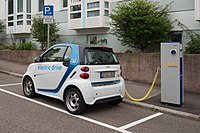Electric vehicle
- Alemannisch
- العربية
- বাংলা
- Български
- Català
- Dansk
- Deutsch
- Eesti
- Ελληνικά
- Español
- Esperanto
- Euskara
- فارسی
- Français
- Gaeilge
- ગુજરાતી
- 한국어
- हिन्दी
- Bahasa Indonesia
- Íslenska
- Italiano
- Kreyòl ayisyen
- Kurdî
- മലയാളം
- မြန်မာဘာသာ
- Nederlands
- नेपाली
- 日本語
- Nordfriisk
- پښتو
- Polski
- Português
- Română
- Русский
- Shqip
- Simple English
- Slovenščina
- کوردی
- Svenska
- Türkçe
- Українська
- Tiếng Việt
- 粵語
- 中文
This article duplicates the scope of other articles, specifically Electric car. Please discuss this issue and help introduce a summary style to the article. (March 2024) |
An electric vehicle (EV) is a vehicle that uses one or more
- Electric car, a BMW i3 charging from a standard electrical outlet.
- circumnavigatedthe globe
- solar-powered boatto circumnavigate the world
- Electric San'yo Shinkansen, Japan
- Battery electric bus, a BYD bus in Landskrona, Sweden
- E-bike, a Geero, with the removable battery integrated into the down tube.
- Class 8, a Tesla Semiin Rocklin, California
- Electric cart, an Italcar Attiva C2S.4
Early electric vehicles first came into existence in the late 19th century, when the
Progress in batteries, electric motors and power electronics have made electric cars more feasible than during the 20th century. As a means of reducing tailpipe emissions of carbon dioxide and other pollutants, and to reduce use of fossil fuels, government incentives are available in many areas to promote the adoption of electric cars and trucks.
History
Electric motive power started in 1827 when Hungarian priest
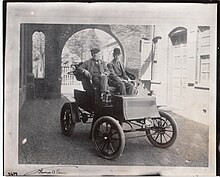
The first mass-produced electric vehicles appeared in America in the early 1900s. In 1902, the Studebaker Automobile Company entered the automotive business with electric vehicles, though it also entered the gasoline vehicles market in 1904. However, with the advent of cheap assembly line cars by Ford Motor Company, the popularity of electric cars declined significantly.[5]
Due to lack of electricity grids
Electrified trains were used for coal transport, as the motors did not use the valuable
EVs were among the earliest automobiles, and before the preeminence of light, powerful
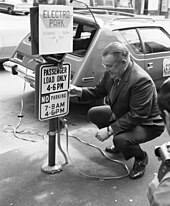
Most producers of passenger cars opted for gasoline cars in the first decade of the 20th century, but electric trucks were an established niche well into the 1920s.
In the 1930s,
The Copenhagen Summit, which was conducted in the midst of a severe observable climate change brought on by human-made greenhouse gas emissions, was held in 2009. During the summit, more than 70 countries developed plans to eventually reach net zero. For many countries, adopting more EVs will help reduce the use of gasoline.[17]
Experimentation

In January 1990, General Motors President introduced its EV concept two-seater, the "Impact", at the Los Angeles Auto Show. That September, the California Air Resources Board mandated major-automaker sales of EVs, in phases starting in 1998. From 1996 to 1998 GM produced 1117 EV1s, 800 of which were made available through three-year leases.[18]
Chrysler, Ford, GM, Honda, and Toyota also produced limited numbers of EVs for California drivers during this time period. In 2003, upon the expiration of GM's EV1 leases, GM discontinued them. The discontinuation has variously been attributed to:
- the auto industry's successful federal court challenge to California's zero-emissions vehiclemandate,
- a federal regulation requiring GM to produce and maintain spare parts for the few thousand EV1s and
- the success of the oil and auto industries' media campaign to reduce public acceptance of EVs.
A movie made on the subject in 2005–2006 was titled
Ford released a number of their Ford Ecostar delivery vans into the market. Honda, Nissan and Toyota also repossessed and crushed most of their EVs, which, like the GM EV1s, had been available only by closed-end lease. After public protests, Toyota sold 200 of its RAV4 EVs; they later sold at over their original forty-thousand-dollar price. Later, BMW of Canada sold off a number of Mini EVs when their Canadian testing ended.
The production of the
Reintroduction
The
Electricity sources
There are many ways to generate electricity, of varying costs, efficiency and ecological desirability.
Connection to generator plants
- Direct connection to overhead lines, third rail and conduit current collection)
- Online electric vehicle collects power from electric power strips buried under the road surface through electromagnetic induction
Onboard generators and hybrid EVs
- Generated on-board using a diesel engine: diesel–electriclocomotive and diesel–electric multiple unit (DEMU)
- Generated on-board using a fuel cell: fuel cell vehicle
- Generated on-board using nuclear energy: nuclear submarines and aircraft carriers
- Renewable sources such as solar power: solar vehicle
It is also possible to have hybrid EVs that derive electricity from multiple sources, such as:
- On-board rechargeable electricity storage system (RESS) and a direct continuous connection to land-based generation plants for purposes of on-highway recharging with unrestricted highway range[25]
- On-board rechargeable electricity storage system and a fueled propulsion power source (internal combustion engine): plug-in hybrid
For especially large EVs, such as submarines, the chemical energy of the diesel–electric can be replaced by a nuclear reactor. The nuclear reactor usually provides heat, which drives a steam turbine, which drives a generator, which is then fed to the propulsion. See Nuclear marine propulsion.
A few experimental vehicles, such as some cars and a handful of aircraft use solar panels for electricity.
Onboard storage
| Vehicle type | Fuel used |
|---|---|
| All-petroleum vehicle (aka all-combustion vehicle) |
Most use of petroleum or other fuel. |
| Regular hybrid electric vehicle |
Less use of petroleum or other fuel, but unable to be plugged in. |
| Plug-in hybrid vehicle | Less use of petroleum or other fuel, residual use of electricity. |
| All-electric vehicle (BEV, AEV) |
Exclusively uses electricity. |
These systems are powered from an external generator plant (nearly always when stationary), and then disconnected before motion occurs, and the electricity is stored in the vehicle until needed.
- Full Electric Vehicles (FEV).[26] Power storage methods include:
- lithium-ionbattery
- Kinetic energy storage: flywheels
- Static energy stored on the vehicle in on-board electric double-layer capacitors
Batteries,
Lithium-ion battery

Most electric vehicles use lithium-ion batteries (Li-Ions or LIBs). Lithium-ion batteries have a higher energy density, longer life span, and higher power density than most other practical batteries.[30] Complicating factors include safety, durability, thermal breakdown, environmental impact, and cost. Li-ion batteries should be used within safe temperature and voltage ranges to operate safely and efficiently.[31]
Increasing the battery's lifespan decreases effective costs and environmental impact. One technique is to operate a subset of the battery cells at a time and switching these subsets.[32]
In the past, nickel–metal hydride batteries were used in some electric cars, such as those made by General Motors.[33] These battery types are considered outdated due to their tendencies to self-discharge in the heat.[34] Furthermore, a patent for this type of battery was held by Chevron, which created a problem for their widespread development.[35] These factors, coupled with their high cost, has led to lithium-ion batteries leading as the predominant battery for EVs.[36]
The prices of lithium-ion batteries have declined dramatically over the past decade, contributing to a reduction in price for electric vehicles, but an increase in the price of critical minerals such as lithium from 2021 to the end of 2022 has put pressure on historical battery price decreases.[37][38]
Electric motor

The power of a vehicle's electric motor, as in other machines, is measured in kilowatts (kW). Electric motors can deliver their maximum torque over a wide RPM range. This means that the performance of a vehicle with a 100 kW electric motor exceeds that of a vehicle with a 100 kW internal combustion engine, which can only deliver its maximum torque within a limited range of engine speed.
Efficiency of charging varies considerably depending on the type of charger,[39] and energy is lost during the process of converting the electrical energy to mechanical energy.
Usually, direct current (DC) electricity is fed into a DC/AC inverter where it is converted to alternating current (AC) electricity and this AC electricity is connected to a 3-phase AC motor.
For electric trains,
Energy and motors

Most large electric transport systems are powered by stationary sources of electricity that are directly connected to the vehicles through wires. Electric traction allows the use of regenerative braking, in which the motors are used as brakes and become generators that transform the motion of, usually, a train into electrical power that is then fed back into the lines. This system is particularly advantageous in mountainous operations, as descending vehicles can produce a large portion of the power required for those ascending. This regenerative system is only viable if the system is large enough to use the power generated by descending vehicles.
In the systems above, motion is provided by a
Vehicle types
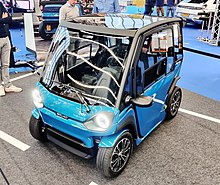
It is generally possible to equip any kind of vehicle with an electric power-train.
Ground vehicles
Pure-electric vehicles
A pure-electric vehicle or all-electric vehicle is powered exclusively through electric motors. The electricity may come from a battery (battery electric vehicle), solar panel (solar vehicle) or fuel cell (fuel cell vehicle).
Hybrid EVs
A
There are different ways that a hybrid electric vehicle can combine the power from an electric motor and the internal combustion engine. The most common type is a parallel hybrid that connects the engine and the electric motor to the wheels through mechanical coupling. In this scenario, the electric motor and the engine can drive the wheels directly. Series hybrids only use the electric motor to drive the wheels and can often be referred to as extended-range electric vehicles (EREVs) or range-extended electric vehicles (REEVs). There are also series-parallel hybrids where the vehicle can be powered by the engine working alone, the electric motor on its own, or by both working together; this is designed so that the engine can run at its optimum range as often as possible.[44]
Plug-in electric vehicle
A plug-in electric vehicle (PEV) is any
Range-extended electric vehicle
A range-extended electric vehicle (REEV) is a vehicle powered by an electric motor and a plug-in battery. An auxiliary combustion engine is used only to supplement battery charging and not as the primary source of power.[52]
On- and off-road EVs
On-road electric vehicles include electric cars, electric trolleybuses,
.Railborne EVs
The fixed nature of a rail line makes it relatively easy to power EVs through permanent
Since electric trains do not need to carry a heavy internal combustion engine or large batteries, they can have very good
There are also battery electric passenger trains operating on non-electrified rail lines.
Seaborne EVs

Airborne EVs

Since the beginnings of aviation, electric power for aircraft has received a great deal of experimentation. Currently, flying electric aircraft include piloted and unpiloted aerial vehicles.
Electrically powered spacecraft
Electric power has a long history of use in
Space rover vehicles
Crewed and uncrewed vehicles have been used to explore the
Records

- Rimac Nevera, an electric hypercar, set 23 world speed records in one day.[65][66]
- Fastest acceleration of an electric car, 0 to 100 km/h in 1.461 seconds by university students at the University of Stuttgart.[67]
- Electric Land Speed Record 353 mph (568 km/h).[68]
- Electric Car Distance Record 1,725 miles (2,776 km) in 24 hours by Bjørn Nyland.[69]
- Greatest distance by electric vehicle, single charge 999.5 miles (1,608.5 km).[70]
- Solar-powered EV is fastest EV to go over 1,000 km without stopping to recharge, the Sunswift 7.[71]
- Electric Motorcycle: 1,070 miles (1,720 km) under 24 hours. Michel von Tell on a Harley LiveWire.[72]
- Electric flight: 439.5 miles (707.3 km) without charge.[73]
Properties
Components
The type of
Energy sources
EVs are much more efficient than fossil fuel vehicles and have few direct emissions. At the same time, they do rely on electrical energy that is generally provided by a combination of non-fossil fuel plants and fossil fuel plants. Consequently, EVs can be made less polluting overall by modifying the source of electricity. In some areas, persons can ask utilities to provide their electricity from renewable energy.
Fossil fuel vehicle efficiency and pollution standards take years to filter through a nation's fleet of vehicles. New efficiency and pollution standards rely on the purchase of new vehicles, often as the current vehicles already on the road reach their end-of-life. Only a few nations set a retirement age for old vehicles, such as Japan or Singapore, forcing periodic upgrading of all vehicles already on the road.
Batteries

An electric-vehicle battery (EVB) in addition to the traction battery specialty systems used for industrial (or recreational) vehicles, are batteries used to power the propulsion system of a battery electric vehicle (BEVs). These batteries are usually a secondary (rechargeable) battery, and are typically lithium-ion batteries.
Traction batteries, specifically designed with a high ampere-hour capacity, are used in forklifts, electric golf carts, riding floor scrubbers, electric motorcycles, electric cars, trucks, vans, and other electric vehicles.[74][75]
Charging
Grid capacity
If almost all road vehicles were electric it would increase global demand for electricity by up to 25% by 2050 compared to 2020.[76][need quotation to verify] However, overall energy consumption and emissions would diminish because of the higher efficiency of EVs over the entire cycle, and the reduction in energy needed to refine fossil fuels.
Charging stations
- Top-left: a Tesla Roadster (2008) being charged at an electric charging station in Iwata city, Japan.
- Top-right: electric motorcycle at an AeroVironmentcharging station and Pay as you go electric vehicle charging point.
- Bottom-left: Nissan Leaf recharging from a NRG Energy eVgo station in Houston, Texas.
- Bottom-right: converted Toyota Priuses recharging at public charging stations in San Francisco (2009).
A
There are two main types of EV chargers:
Charging stations provide connectors that conform to a variety of international standards. DC charging stations are commonly equipped with multiple connectors to be able to charge a wide variety of vehicles that utilize competing standards.
Public charging stations are typically found street-side or at retail shopping centers, government facilities, and other parking areas. Private charging stations are typically found at residences, workplaces, and hotels.Battery swapping
Instead of recharging EVs from electric sockets, batteries could be mechanically replaced at special stations in a few minutes (battery swapping).
Batteries with greater energy density such as metal-air fuel cells cannot always be recharged in a purely electric way, so some form of mechanical recharge may be used instead. A zinc–air battery, technically a fuel cell, is difficult to recharge electrically so may be "refueled" by periodically replacing the anode or electrolyte instead.[77]
Dynamic charging
| Type(and developer) | Power perreceiver(and powerpending furtherdevelopment) | Million SEKper km roadboth ways | References |
|---|---|---|---|
| Overhead powerlines (Siemens) | 650 kW(1000 kW) | 12.4 | [78]: 140–144 [79]: 23–24, 54 |
| Ground-level power supplythrough in-road rail(Elways and NCC consortium) | 200 kW(800 kW) | 9.4–10.5 | [78]: 146–149 [79]: 21–23, 54 |
| Ground-level power supplythrough on-road rail(Elonroad and ABB consortium) | 150 kW(500 kW) | 11.5–15.3 | [79]: 25–26, 54 |
Electreon ) |
25 kW(40 kW) | 19.5–20.8 | [78]: 171–172 [79]: 26–28, 54 |
The
Other in-development technologies
This section needs expansion with: up-to-date information. You can help by adding to it . (July 2021) |
Conventional
Safety
This section needs expansion with: up-to-date information. You can help by adding to it. (July 2021) |
The United Nations in Geneva (
Environmental

EVs release no tailpipe air pollutants, and reduce respiratory illnesses such as asthma.[91] However, EVs are charged with electricity that may be generated by means that have health and environmental impacts.[92][93]
The carbon emissions from producing and operating an EV are in the majority of cases less than those of producing and operating a conventional vehicle.[94] EVs in urban areas almost always pollute less than internal combustion vehicles.[95]
One limitation of the environmental potential of EVs is that simply switching the existing privately owned car fleet from ICEs to EVs will not free up road space for active travel or public transport.[96] Electric micromobility vehicles, such as e-bikes, may contribute to the decarbonisation of transport systems, especially outside of urban areas which are already well-served by public transport.[97]
Internal combustion engined vehicles use far more raw materials over their lifetime than EVs.[98]
Lithium-ion batteries
Since their first commercial release in 1991, lithium-ion batteries have become an important technology for achieving low-carbon transportation systems. Information regarding the sustainability of production process of batteries has become a politically charged topic.
Business processes of raw material extraction in practice raise issues of transparency and accountability of the management of extractive resources. In the complex supply chain of lithium technology, there are diverse stakeholders representing corporate interests, public interest groups and political elites that are concerned with outcomes from the technology production and use. One possibility to achieve balanced extractive processes would be the establishment of commonly agreed standards on the governance of technology worldwide.[99]
The compliance of these standards can be assessed by the Assessment of Sustainability in Supply Chains Frameworks (ASSC). Hereby, the qualitative assessment consists of examining governance and social and environmental commitment. Indicators for the quantitative assessment are management systems and standards, compliance and social and environmental indicators.[100]
One source estimates that over a fifth of the lithium and about 65% of the cobalt needed for electric cars will be from recycled sources by 2035.[101] On the other hand, when counting the large quantities of fossil fuel non-electric cars consume over their lifetime, electric cars can be considered to dramatically reduce raw-material needs.[101]
In 2022, the manufacturing of an EV emitted on average around 50% more CO2 than an equivalent internal combustion engine vehicle, but this difference is more than offset by the much higher emissions from the oil used in driving an internal combustion engine Vehicle over its lifetime compared to those from generating the electricity used for driving the EV.[102]
In 2023, Greenpeace issued a video criticizing the view that EVs are "silver bullet for climate", arguing that the construction phase has a high environmental impact. For example, the rise in SUV sales by Hyundai almost eliminate the climate benefits of passing to EV in this company, because even electric SUVs have a high carbon footprint as they consume much raw materials and energy during construction. Greenpeace proposes a mobility as a service concept instead, based on biking, public transport and ride sharing.[103]
Socio-economic
A 2003 study in the United Kingdom found that "[p]ollution is most concentrated in areas where young children and their parents are more likely to live and least concentrated in areas to which the elderly tend to migrate," and that "those communities that are most polluted and which also emit the least pollution tend to be amongst the poorest in Britain."[104] A 2019 UK study found that "households in the poorest areas emit the least NOx and PM, whilst the least poor areas emitted the highest, per km, vehicle emissions per household through having higher vehicle ownership, owning more diesel vehicles and driving further."[105]
Mechanical
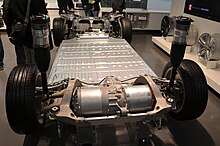
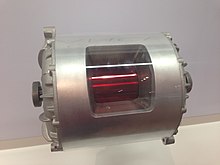
Electric motors are mechanically very simple and often achieve 90% energy conversion efficiency[106] over the full range of speeds and power output and can be precisely controlled. They can also be combined with regenerative braking systems that have the ability to convert movement energy back into stored electricity. This can be used to reduce the wear on brake systems (and consequent brake pad dust) and reduce the total energy requirement of a trip. Regenerative braking is especially effective for start-and-stop city use.
They can be finely controlled and provide high torque from stationary-to-moving, unlike internal combustion engines, and do not need multiple gears to match power curves. This removes the need for
EVs provide quiet and smooth operation and consequently have less noise and vibration than internal combustion engines.[107] While this is a desirable attribute, it has also evoked concern that the absence of the usual sounds of an approaching vehicle poses a danger to blind, elderly and very young pedestrians. To mitigate this situation, many countries mandate warning sounds when EVs are moving slowly, up to a speed when normal motion and rotation (road, suspension, electric motor, etc.) noises become audible.[108]
Electric motors do not require oxygen, unlike internal combustion engines; this is useful for submarines and for space rovers.
Energy resilience
Electricity can be produced from a variety of sources; therefore, it gives the greatest degree of
Energy efficiency
EV '
Well-to-wheel efficiency of an EV has less to do with the vehicle itself and more to do with the method of electricity production. A particular EV would instantly become twice as efficient if electricity production were switched from fossil fuels to renewable energy, such as wind power, tidal power, solar power, and nuclear power. Thus, when "well-to-wheels" is cited, the discussion is no longer about the vehicle, but rather about the entire energy supply infrastructure – in the case of fossil fuels this should also include energy spent on exploration, mining, refining, and distribution.[citation needed]
The lifecycle analysis of EVs shows that even when powered by the most carbon-intensive electricity in Europe, they emit less greenhouse gases than a conventional diesel vehicle.[110]
Total cost
As of 2021[update] the purchase price of an EV is often more, but the
European carmakers face significant pressure from more affordable Chinese models and price cuts by US-based Tesla Motor. From 2021 to 2022, the European market share of Chinese EV manufacturers doubled to almost 9%, prompting the CEO of Stellantis to describe it as an "invasion".[114]
Range
Electric vehicles may have shorter range compared to vehicles with internal combustion engines,[115][116] which is why the electrification of long-distance transport, such as long-distance shipping, remains challenging.
In 2022, the sales-weighted average range of small BEVs sold in the United States was nearly 350 km, while in France, Germany and the United Kingdom it was just under 300 km, compared to under 220 km in China.[87]
Heating of EVs
Well insulated cabins can heat the vehicle using the body heat of the passengers. This is not enough, however, in colder climates as a driver delivers only about 100 W of heating power. A heat pump system, capable of cooling the cabin during summer and heating it during winter, is an efficient way of heating and cooling EVs.[117] For vehicles which are connected to the grid, battery EVs can be preheated, or cooled, with little or no need for battery energy, especially for short trips. Most new electric cars come with heat pumps as standard.[118]
Electric public transit efficiency
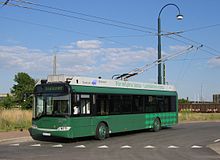
Shifts from private to public transport (train, trolleybus, personal rapid transit or tram) have the potential for large gains in efficiency in terms of an individual's distance traveled per kWh.
Research shows people prefer trams to buses,[119] because they are quieter and more comfortable and perceived as having higher status.[120] Therefore, it may be possible to cut liquid fossil fuel consumption in cities through the use of electric trams. Trams may be the most energy-efficient form of public transportation, with rubber-wheeled vehicles using two-thirds more energy than the equivalent tram, and run on electricity rather than fossil fuels.
In terms of
Government incentivization
The IEA suggests that taxing inefficient internal combustion engine vehicles could encourage adoption of EVs, with taxes raised being used to fund subsidies for EVs.[87] Government procurement is sometimes used to encourage national EV manufacturers.[122][123] Many countries will ban sales of fossil fuel vehicles between 2025 and 2040.[124]
Many governments offer incentives to promote the use of electric vehicles, with the goals of reducing air pollution and oil consumption. Some incentives intend to increase purchases of electric vehicles by offsetting the purchase price with a grant. Other incentives include lower tax rates or exemption from certain taxes, and investment in charging infrastructure.
Companies selling EVs have partnered with local electric utilities to provide large incentives on some electric vehicles.[125]
Future

Public perception
A European survey based on climate found that as of 2022, 39% of European citizens tend to prefer hybrid vehicles, 33% prefer petrol or diesel vehicles, followed by electric cars which were preferred by 28% of Europeans.[126] 44% Chinese car buyers are the most likely to buy an electric car, while 38% of Americans would opt for a hybrid car, 33% would prefer petrol or diesel, while only 29% would go for an electric car.[126]
In a 2023 survey concentrated specifically on electric car ownership in the US, 50% of respondents planning to purchase a future car considered themselves unlikely to seriously consider buying an EV. The survey also found that support for banning the production of non-electric vehicles in the US by 2035 has declined from 47% to 40%.[127]

Environmental considerations
By reducing types of air pollution, such as nitrogen dioxide, EVs could prevent hundreds of thousands of early deaths every year,[129][130] especially from trucks and traffic in cities.[131]
The full environmental impact of electric vehicles includes the life cycle impacts of carbon and sulfur emissions, as well as toxic metals entering the environment.
Rare-earth metals (neodymium, dysprosium) and other mined metals (copper, nickel, iron) are used by EV motors, while lithium, cobalt, manganese are used by the batteries.[132][133] In 2023 the US State Department said that the supply of lithium would need to increase 42-fold by 2050 globally to support a transition to clean energy.[134] Most of the lithium ion battery production occurs in China, where the bulk of energy used is supplied by coal burning power plants. A study of hundreds of cars on sale in 2021 concluded that the life cycle GHG emissions of full electric cars are slightly less than hybrids and that both are less than gasoline and diesel fuelled cars.[135]
An alternative method of sourcing essential battery materials being deliberated by the International Seabed Authority is deep sea mining, however carmakers are not using this as of 2023.[136]
Improved batteries
Advances in lithium-ion batteries, driven at first by the personal-use electronics industry, allow full-sized, highway-capable EVs to travel nearly as far on a single charge as conventional cars go on a single tank of gasoline. Lithium batteries have been made safe, can be recharged in minutes instead of hours (see recharging time), and now last longer than the typical vehicle (see lifespan). The production cost of these lighter, higher-capacity lithium-ion batteries is gradually decreasing as the technology matures and production volumes increase.[137][138] Research is also underway to improve battery reuse and recycling, which would further reduce the environmental impact of batteries.[139][140]

Many companies and researchers are also working on newer battery technologies, including solid state batteries[141] and alternate technologies.[142]
Battery management and intermediate storage
Another improvement is to decouple the electric motor from the battery through electronic control, using supercapacitors to buffer large but short power demands and regenerative braking energy.[143] The development of new cell types combined with intelligent cell management improved both weak points mentioned above. The cell management involves not only monitoring the health of the cells but also a redundant cell configuration (one more cell than needed). With sophisticated switched wiring, it is possible to condition one cell while the rest are on duty.[citation needed]
Electric trucks

An
Electric trucks have serviced niche applications like milk floats, pushback tugs and forklifts for over a hundred years, typically using lead-acid batteries, but the rapid development of lighter and more energy-dense battery chemistries in the twenty-first century has broadened the range of applicability of electric propulsion to trucks in many more roles.
Electric trucks reduce noise and pollution, relative to internal-combustion trucks. Due to the high efficiency and low component-counts of electric power trains, no fuel burning while idle, and silent and efficient acceleration, the costs of owning and operating electric trucks are dramatically lower than their predecessors.
Long-distance freight has been the trucking segment least amenable to electrification, since the increased weight of batteries, relative to fuel, detracts from payload capacity, and the alternative, more frequent recharging, detracts from delivery time. By contrast, short-haul urban delivery has been electrified rapidly, since the clean and quiet nature of electric trucks fit well with urban planning and municipal regulation, and the capacities of reasonably sized batteries are well-suited to daily stop-and-go traffic within a metropolitan area.[148][149][150]
In South Korea, electric trucks hold a noticeable share of the new truck market; in 2020, among trucks produced and sold domestically (which are the vast majority of new trucks sold in the country), 7.6% were all-electric vehicles.[151]Hydrogen trains
Particularly in Europe,
Higher voltage outlets in garages of newly built homes
In
Bidirectional charging
General Motors (GM) is adding a capability called V2H, or bidirectional charging, to allow its new electric vehicles to send power from their batteries to the owner's home. GM will start with 2024 models, including the Silverado and Blazer EVs, and promises to continue the feature through to model year 2026. This could be helpful to the owner during unexpected power grid outages because an electric vehicle is a giant battery on wheels.[160]
Infrastructure management
With the increase in number of electric vehicles, it is necessary to create an appropriate number of charging stations to supply the increasing demand,[161] and a proper management system that coordinates the charging turn of each vehicle to avoid having some charging stations overloaded with vehicles and others empty.[162]
Stabilization of the grid

Since EVs can be plugged into the
Current electricity infrastructure may need to cope with increasing shares of variable-output power sources such as wind and
Some concepts see battery exchanges and battery charging stations, much like gas/petrol stations today. These will require enormous storage and charging potentials, which could be manipulated to vary the rate of charging, and to output power during shortage periods, much as diesel generators are used for short periods to stabilize some national grids.[167][168]
Repair shops
The infrastructure for vehicle repairs after accidents is a concern for insurers and mechanics due to safety requirements.
See also
- Electric rickshaw – E-tricycle
- Neighborhood Electric Vehicle – NEV
- Polluter pays principle
- Alternative fuel vehicle
- Vehicle classification by propulsion system
Notes
References
- ISBN 978-0-8213-3444-7. Archivedfrom the original on 4 July 2021. Retrieved 4 December 2017.
- S2CID 37828220.
- ^ Bellis, Mary (16 June 2010). "Inventors – Electric Cars (1890–1930)". Inventors.about.com. Archived from the original on 4 July 2021. Retrieved 26 December 2010.
- ^ "History of Railway Electric Traction". Mikes.railhistory.railfan.net. Archived from the original on 24 August 2018. Retrieved 26 December 2010.
- ^ Hendry, Maurice M. Studebaker: One can do a lot of remembering in South Bend. New Albany, Indiana: Automobile Quarterly. pp. 228–275. Vol X, 3rd Q, 1972. p231
- ^ S2CID 242383930.
- ^ pp.8–9 Batten, Chris Ambulances Osprey Publishing, 4 March 2008
- ^ "Escaping Lock-in: the Case of the Electric Vehicle". Cgl.uwaterloo.ca. Archived from the original on 23 September 2015. Retrieved 26 December 2010.
- ^ AAA World Magazine. Jan–Feb 2011, p. 53
- ^ Kirsch, David (2000). The electric vehicle and the burden of history. Rutgers University Press.
- ISBN 978-1-4214-1268-9.
- ^ See Loeb, A.P., "Steam versus Electric versus Internal Combustion: Choosing the Vehicle Technology at the Start of the Automotive Age," Transportation Research Record, Journal of the Transportation Research Board of the National Academies, No. 1885, at 1.
- ^ Automobile, archived from the original on 30 April 2015, retrieved 18 July 2009
- ^ Scharff, Virginia (1992). Taking the Wheel: Women and the Coming of the Motor Age. Univ. New Mexico Press.
- ISBN 978-0-444-59513-3. Archivedfrom the original on 9 October 2020. Retrieved 4 May 2014.
- About.com, archivedfrom the original on 4 July 2021, retrieved 6 July 2006
- ^ "Net Zero Coalition". United Nations. Retrieved 2 December 2022.
- ^ Quiroga, Tony (August 2009). Driving the Future. Hachette Filipacchi Media U.S., Inc. p. 52.
- ^ Freeman, Sunny (9 December 2009). "The end of Zenn". The Globe and Mail. Toronto. Retrieved 25 May 2022.
- ^ "Global EV Outlook 2023 / Trends in electric light-duty vehicles". International Energy Agency. April 2023. Archived from the original on 12 May 2023.
- ^ Data from McKerracher, Colin (12 January 2023). "Electric Vehicles Look Poised for Slower Sales Growth This Year". BloombergNEF. Archived from the original on 12 January 2023.
- from the original on 21 October 2013. Retrieved 8 June 2010.
- ISSN 1754-5692.
- PMID 20695466.
- ^ "World's first electrified road for charging vehicles opens in Sweden". Guardian. 12 April 2018. Archived from the original on 1 September 2019. Retrieved 1 September 2019.
- .
- .
- ^ a b "Race to Net Zero: The Pressures of the Battery Boom in Five Charts". 21 July 2022. Archived from the original on 7 September 2023.
- ^ Medimorec, Nikola (8 February 2013). "Namsan E-Bus, First Commercial Electric Bus Worldwide". Kojects.
- S2CID 225154703.
- ISSN 0378-7753.
- ISSN 0378-7753.
- ^ Mok, Brian. "Types of Batteries Used for Electric Vehicles". large.stanford.edu. Archived from the original on 19 December 2017. Retrieved 30 November 2017.
- ^ "Alternative Fuels Data Center: Batteries for Hybrid and Plug-In Electric Vehicles". afdc.energy.gov. AFDC. Archived from the original on 1 December 2017. Retrieved 30 November 2017.
- ^ "Chevron and EVs – GM, Chevron and CARB killed the sole NiMH EV once, will do so again". ev1.org. Archived from the original on 22 November 2017. Retrieved 30 November 2017.
- ^ Aditya, Jayam; Ferdowsi, Mehdi. "Comparison of NiMH and Li-Ion Batteries in Automotive Applications". Power Electronics and Motor Drives Laboratory. Archived from the original on 1 December 2017. Retrieved 30 November 2017.
- ^ "Global EV Outlook 2023 – Data product". IEA. Retrieved 30 June 2023.
- ^ "Bloomberg's Latest Forecast Predicts Rapidly Falling Battery Prices". 21 June 2018. Archived from the original on 8 January 2019. Retrieved 4 January 2019.
- ^ Voelcker, John (10 April 2021). "EVs Explained: Charging Losses". Car and Driver. Archived from the original on 27 July 2021. Retrieved 27 July 2021.
- ISSN 2214-9937.
- ^ "Electric Driveline Technology – PVI, leader de la traction électrique pour véhicules industriels". Pvi.fr. Archived from the original on 25 March 2012. Retrieved 30 March 2012.
- ^ "History of Hybrid Vehicles". HybridCars.com. 27 March 2006. Archived from the original on 8 February 2009. Retrieved 21 March 2010.
- ^ "Alternative Fuels Data Center: How do Hybrid Electric Cars Work?".
- ^ Spendiff-Smith, Matthew (18 March 2022). "Electric Vehicles Types – A Complete Guide to Types of EV – EVESCO". Power Sonic.
- ^ a b Dan Mihalascu (4 November 2022). "Turkey's National Carmaker Togg Starts Production Of 2023 C SUV EV". insideevs.com.
- ^ "TOGG Official Website". togg.com.tr. Retrieved 3 April 2020.
- ^ Jay Ramey (30 December 2019). "Turkey Bets on EVs with the Pininfarina-Designed TOGG". autoweek.com.
- ^ "'A game changer': Türkiye inaugurates its first national car plant". TRT World. 30 October 2022.
- ISBN 978-0-8157-0305-1. Archivedfrom the original on 28 March 2019. Retrieved 7 July 2013. See definition on pp. 2.
- ^ "Plug-in Electric Vehicles (PEVs)". Center for Sustainable Energy, California. Archived from the original on 20 June 2010. Retrieved 31 March 2010.
- ^ "PEV Frequently Asked Questions". Duke Energy. Archived from the original on 27 March 2012. Retrieved 24 December 2010.
- ^ "Electric road vehicles in the European Union" (PDF). europa.eu. Archived (PDF) from the original on 14 February 2020. Retrieved 24 October 2020.
- ^ "-Maglev Technology Explained". North American Maglev Transport Institute. 1 January 2011. Archived from the original on 27 July 2011.
- ^ "Oceanvolt – Complete Electric Motor Systems". Oceanvolt. Archived from the original on 24 December 2012. Retrieved 30 November 2012.
- ^ Stensvold, Tore. "Lønnsomt å bytte ut 70 prosent av fergene med batteri- eller hybridferger Archived 5 January 2016 at the Wayback Machine" Teknisk Ukeblad, 14. August 2015.
- ^ "S-80: A Sub, for Spain, to Sail Out on the Main". Defense Industry Daily. 15 December 2008. Archived from the original on 24 February 2010. Retrieved 17 December 2009.
- ^ "Ports of Auckland Sparky: The 200 Best Inventions of 2022". Time. 10 November 2022. Retrieved 26 March 2024.
- ^ Mandra, Jasmina Ovcina (27 October 2023). "Electrifying Debut: HaiSea Wamis completes its 1st tanker escort with full electric power". Offshore Energy. Retrieved 26 March 2024.
- ^ "The little (electric) engine that could: The Port of San Diego unveils the nation's first all-electric tug boat". San Diego Union-Tribune. 11 March 2024. Retrieved 26 March 2024.
- ^ "Contributions to Deep Space 1". 14 April 2015. Archived from the original on 10 December 2004. Retrieved 4 August 2016.
- ^ Cybulski, Ronald J.; Shellhammer, Daniel M.; Lovell, Robert R.; Domino, Edward J.; Kotnik, Joseph T. (1965). "Results from SERT I Ion Rocket Flight Test" (PDF). NASA. NASA-TN-D-2718. Archived (PDF) from the original on 12 November 2020. Retrieved 12 November 2020.
- ^ Lyons, Pete; "10 Best Ahead-of-Their-Time Machines", Car and Driver, Jan. 1988, p.78
- ^ "Technologies of Broad Benefit: Power". Archived from the original on 18 January 2017. Retrieved 6 September 2018.
- ^ "Soviet Union Lunar Rovers". Archived from the original on 2 November 2018. Retrieved 6 September 2018.
- ^ Ulrich, Lawrence. "Rimac Nevera EV Sets 23 World Speed Records: Zero to 400 kilometers per hour and back again in under 30 seconds was just one of them". IEEE Spectrum.
- ^ Doll, Scooter. "Rimac Nevera electric hypercar sets 23 records in single day, including fastest 0–249 mph time". Electrek.
- ^ Addow, Amina. "Electric car goes from 0 to 100 km/h in 1.461 seconds". Guinness World Records.
- ^ "interestingengineering.com". November 2021.
- ^ Holl, Maximilian (5 July 2019). "Tesla Model 3 Breaks World EV Distance Record — 2,781 km (1,728 mi) Travelled in 24 Hours". CleanTechnica. Retrieved 15 May 2022.
- ^ "Greatest distance by electric vehicle, single charge (non-solar)". Guinness World Records. 16 October 2017. Retrieved 15 May 2022.
- ^ Jamieson, Craig. "This solar-powered EV is a world-record-breaking speed machine*". BBC Top Gear. BBC Studios.
- ^ "Harley-Davidson's LiveWire EV | GreenCars". www.greencars.com. Retrieved 15 May 2022.
- ^ Toll, Micah (29 August 2020). "Believe it or not, this electric plane is set to break 7 world records in one trip". Electrek. Retrieved 15 May 2022.
- ISSN 0885-8985. Retrieved 3 September 2022.
- ISBN 978-94-010-8786-5. Retrieved 3 September 2022.
- ^ "EVO Report 2021 | BloombergNEF | Bloomberg Finance LP". BloombergNEF. Archived from the original on 27 July 2021. Retrieved 27 July 2021.
- ISBN 9780444538819. Retrieved 29 October 2022.
- ^ a b c d e D Bateman; et al. (8 October 2018), Electric Road Systems: a solution for the future (PDF), TRL, archived (PDF) from the original on 3 August 2020, retrieved 10 February 2021
- ^ a b c d e Analysera förutsättningar och planera för en utbyggnad av elvägar, Swedish Transport Administration, 2 February 2021, archived from the original on 3 February 2021, retrieved 10 February 2021
- ^ Regler för statliga elvägar SOU 2021:73 (PDF), Regeringskansliet (Government Offices of Sweden), 1 September 2021, pp. 69–87, archived from the original (PDF) on 2 September 2021
- ^ European Commission (14 July 2021), Proposal for a REGULATION OF THE EUROPEAN PARLIAMENT AND OF THE COUNCIL on the deployment of alternative fuels infrastructure, and repealing Directive 2014/94/EU of the European Parliament and of the Council
- ^ Patrick Pélata; et al. (July 2021), Système de route électrique. Groupe de travail n°1 (PDF), archived from the original (PDF) on 21 October 2021
- ^ "PD CLC/TS 50717 Technical Requirements for Current Collectors for ground-level feeding system on road vehicles in operation", The British Standards Institution, 2022, archived from the original on 2 January 2023, retrieved 2 January 2023
- ^ Final draft: Standardization request to CEN-CENELEC on 'Alternative fuels infrastructure' (AFI II) (PDF), European Commission, 2 February 2022, archived from the original (PDF) on 8 April 2022, retrieved 2 January 2023
- ^ Matts Andersson (4 July 2022), Regulating Electric Road Systems in Europe – How can a deployment of ERS be facilitated? (PDF), CollERS2 – Swedish German research collaboration on Electric Road Systems
- .
- ^ a b c d "Global EV Outlook 2023 – Analysis". IEA. 26 April 2023. Retrieved 5 July 2023.
- ^ "EUROPA Press Releases – Car safety: European Commission welcomes international agreement on electric and hybrid cars". Europa (web portal). 10 March 2010. Archived from the original on 16 April 2010. Retrieved 26 June 2010.
- S2CID 220830992.
- ^ "The price of batteries has declined by 97% in the last three decades". Our World in Data. Retrieved 26 April 2022.
- S2CID 256572849.
- PMID 21949359.
- PMID 25512510.
- ^ "A global comparison of the life-cycle greenhouse gas emissions of combustion engine and electric passenger cars | International Council on Clean Transportation". theicct.org. Archived from the original on 9 November 2021. Retrieved 29 July 2021.
- PMID 32858467.
- ISSN 1357-4809.
- ^ "e-bike carbon savings – how much and where? – CREDS". 18 May 2020. Archived from the original on 13 April 2021. Retrieved 13 April 2021.
- ^ "Electric Cars Need Way Less Raw Materials Than ICE Vehicles". InsideEVs. Archived from the original on 28 July 2021. Retrieved 28 July 2021.
- ^ ISSN 1748-9326.
- ISSN 0959-6526.
- ^ a b "Electric car batteries need far less raw materials than fossil-fuel cars – study Archived 2 November 2021 at the Wayback Machine". transportenvironment.org. Retrieved 1 November 2021.
- ^ "Energy Technology Perspectives 2023 – Analysis". IEA. 12 January 2023. Retrieved 30 June 2023.
- ^ "Myths Shattered: The Truth About Electric Cars in Today's Auto Industry". Greenpeace international. Retrieved 21 November 2023.
- ^ Mitchell G, Dorling D. An Environmental Justice Analysis of British Air Quality. Environment and Planning A: Economy and Space. 2003;35(5):909–929. doi:10.1068/a35240
- S2CID 197455092.
- ^ "Better Place" (PDF).
- ^ a b "Transport: Electric vehicles". European Commission. Archived from the original on 19 March 2011. Retrieved 19 September 2009.
- ^ "Nissan Adds 'Beautiful' Noise to Make Silent Electric Cars Safe". Bloomberg L.P. 18 September 2009. Retrieved 12 February 2010.
- ^ "Our Electric Future – The American, A Magazine of Ideas". American.com. Archived from the original on 25 August 2014. Retrieved 26 December 2010.
- ^ Lepetit, Yoann (October 2017). "Electric vehicle life cycle analysis and raw material availability" (PDF). Transport & Environment. Archived (PDF) from the original on 23 February 2018. Retrieved 22 February 2018.
- ^ "2020 European total cost of ownership for electric vehicles vs internal combustion engine vehicles | Nickel Institute". nickelinstitute.org. Archived from the original on 26 July 2021. Retrieved 26 July 2021.
- ^ "Electric cars already cheapest option today for many consumers, new study finds | www.beuc.eu". www.beuc.eu. Archived from the original on 26 July 2021. Retrieved 26 July 2021.
- ^ "Trends and developments in electric vehicle markets – Global EV Outlook 2021 – Analysis". IEA. Archived from the original on 26 July 2021. Retrieved 26 July 2021.
- ^ Guillaume, Gilles; Piovaccari, Giulio (27 July 2023). "Western car makers look to slash EV costs to fight Chinese 'invasion'". Reuters.
- ^ "Explaining Electric & Plug-In Hybrid Electric Vehicles | US EPA". US EPA. 17 August 2015. Archived from the original on 12 June 2018. Retrieved 8 June 2018.
- ^ "Electric vehicle price is rising, but cost-per-mile is falling". Ars Technica. Archived from the original on 4 June 2018. Retrieved 8 June 2018.
- ^ Beedham, Matthew (3 February 2021). "What's a heat pump and why do EVs use them?". TNW | Shift. Archived from the original on 28 July 2021. Retrieved 28 July 2021.
- ^ "Heat pumps in electric vehicles: What are they for? | Inquieto". 26 July 2023. Retrieved 5 November 2023.
- ^ "Trams, energy saving, private cars, trolley buses, diesel buses | Claverton Group". Claverton-energy.com. 28 May 2009. Archived from the original on 19 September 2009. Retrieved 19 September 2009.
- ^ "SUSTAINABLE LIGHT RAIL | Claverton Group". Claverton-energy.com. 21 November 2008. Archived from the original on 16 September 2009. Retrieved 19 September 2009.
- ^ "Blackpool Trams – Then and Now • the seaside way to travel – with Live Blackpool". Blackpool. 9 September 2020. Archived from the original on 30 October 2020. Retrieved 26 November 2020.
- ^ "EESL to procure 10,000 Electric Vehicles from TATA Motors". pib.nic.in. Archived from the original on 8 February 2018. Retrieved 7 February 2018.
- ^ Balachandran, Manu. "As India revs up its grand electric vehicles plan, Tata and Mahindra are in the driver's seat". Quartz. Archived from the original on 8 February 2018. Retrieved 7 February 2018.
- ^ "5 things to know about the future of electric vehicles". World Economic Forum. 12 May 2021. Archived from the original on 16 June 2021. Retrieved 7 June 2021.
- ^ "Accelerating the Transition to Electric School Buses | U.S. PIRG Education Fund". uspirgedfund.org. Archived from the original on 29 July 2021. Retrieved 29 July 2021.
- ^ a b "2021–2022 EIB Climate Survey, part 2 of 3: Shopping for a new car? Most Europeans say they will opt for hybrid or electric". EIB.org. Retrieved 4 April 2022.
- ^ Spencer, Alison; Ross, Stephanie; Tyson, Alec. "How Americans view electric vehicles". Pew Research Center. Retrieved 9 December 2023.
- ^ ISBN 978-92-861-5535-2.
- ^ "Zeroing in on Healthy Air". American Lung Association. 2022.
- S2CID 252471791.
- PMID 36630449.
- S2CID 52227957.
- ^ "Move to net zero 'inevitably means more mining'". BBC News. 24 May 2021. Archived from the original on 4 June 2021. Retrieved 4 June 2021.
- ISSN 0362-4331. Retrieved 12 April 2023.
- S2CID 246758071.
- ISSN 0190-8286. Retrieved 9 April 2023.
- ^ Korosec, Kirsten. "Panasonic boosts energy density, trims cobalt in new 2170 battery cell for Tesla" Archived 29 August 2020 at the Wayback Machine, July 30, 2020
- ^ "Daimler deepens CATL alliance to build long-range, fast-charging EV batteries" Archived 23 August 2020 at the Wayback Machine, Reuters, August 5, 2020; and "Porsche: The perfect cell" Archived 25 November 2020 at the Wayback Machine, Automotive World, August 28, 2020
- ISSN 2380-8195.
- S2CID 115675123.
- ^ Patel, Prachi. "Ion Storage Systems Says Its Ceramic Electrolyte Could Be a Gamechanger for Solid-State Batteries" Archived 29 September 2020 at the Wayback Machine, IEEE.org, February 21, 2020
- ^ Lambert, Fred. "Tesla researchers show path to next-gen battery cell with breakthrough energy density" Archived 24 August 2020 at the Wayback Machine, Electrek, August 12, 2020
- S2CID 187458469.
- ^ "Calculating the total cost of ownership for electric trucks". Transport Dive. Retrieved 27 February 2021.
- ^ "Electric trucking offers fleets ergonomic efficiency potential | Automotive World". www.automotiveworld.com. 11 January 2021. Retrieved 27 February 2021.
- ^ Adler, Alan (8 March 2019). "2019 Work Truck Show: Adoption of Electrification Won't be Fast". Trucks.com. Retrieved 4 April 2019.
- ^ Edelstein, Stephen (17 December 2020). "EV battery pack prices fell 13% in 2020, some are already below $100/kwh". Green Car Reports. Retrieved 13 June 2021.
Electric-car battery-pack prices have fallen 13% in 2020, in some cases reaching a crucial milestone for affordability, according to an annual report released Wednesday by Bloomberg New Energy Finance. Average prices have dropped from $1,100 per kilowatt-hour to $137 per kwh, decrease of 89% over the past decade, according to the analysis. At this time last year, BNEF reported an average price of $156 per kwh—itself a 13% decrease from 2018. Battery-pack prices of less than $100 per kwh were also reported for the first time, albeit only for electric buses in China, according to BNEF. The $100-per-kwh threshold is often touted by analysts as the point where electric vehicles will achieve true affordability. Batteries also achieved $100 per kwh on a per-cell basis, while packs actually came in at $126 per kwh on a volume-weighted average, BNEF noted.
- ^ Domonoske, Camila (17 March 2021). "From Amazon To FedEx, The Delivery Truck Is Going Electric". National Public Radio. Retrieved 13 June 2021.
All major delivery companies are starting to replace their gas-powered fleets with electric or low-emission vehicles, a switch that companies say will boost their bottom lines, while also fighting climate change and urban pollution. UPS has placed an order for 10,000 electric delivery vehicles. Amazon is buying 100,000 from the start-up Rivian. DHL says zero-emission vehicles make up a fifth of its fleet, with more to come. And FedEx just pledged to replace 100% of its pickup and delivery fleet with battery-powered vehicles.
- ^ Joselow, Maxine (11 January 2020). "Delivery Vehicles Increasingly Choke Cities with Pollution". Scientific American. Retrieved 13 June 2021.
Electric vehicles, delivery drones and rules on when delivery trucks can operate are some solutions proposed in a new report. The report provides 24 recommendations for policymakers and the private sector, including mandating that delivery vehicles are electric. The report notes that if policymakers care about sustainability, they may want to impose aggressive new electric vehicle regulations.
- ^ Gies, Erica (18 December 2017). "Electric Trucks Begin Reporting for Duty, Quietly and Without All the Fumes". Inside Climate News. Retrieved 13 June 2021.
Replacing fleets of medium- and heavy-duty trucks can help cut greenhouse gas emissions and make cities quieter and cleaner. Because trucks need so much hauling power, they have eluded electrification until recently; a battery that could pull significant weight would itself be too hefty and too expensive. But now, improvements in battery technology are paying off, bringing down both size and cost. The number of hybrid-electric and electric trucks is set to grow almost 25 percent annually, from 1 percent of the market in 2017 to 7 percent in 2027, a jump from about 40,000 electric trucks worldwide this year to 371,000.
- ^ Hyundai Porter/Porter II Electric: 9037. Kia Bongo EV: 5357. Domestically produced trucks sold in the country: 188222. mk.co.kr autoview.co.kr zdnet.co.kr
- ^ a b "Germany launches world's first hydrogen-powered train". The Guardian. Agence France-Presse. 17 September 2018. Archived from the original on 17 September 2018. Retrieved 29 November 2018.
- ^ "L'Occitanie, première région à commander des trains à hydrogène à Alstom". France 3 Occitanie (in French). Archived from the original on 29 November 2018. Retrieved 29 November 2018.
- ^ "La constructora Alstom quiere ir por el 'tramo ecológico' del Tren Maya". El Financiero (in Spanish). Archived from the original on 29 November 2018. Retrieved 29 November 2018.
- ^ "SNCF : Pépy envisage la fin des trains diesel et l'arrivée de l'hydrogène en 2035". La Tribune (in French). Archived from the original on 29 November 2018. Retrieved 29 November 2018.
- ^ "SNCF : Pépy envisage la fin des trains diesel et l'arrivée de l'hydrogène en 2035". La Tribune (in French). Archived from the original on 29 November 2018. Retrieved 29 November 2018.
- ^ "New Mexico law seeks solar on every roof, and an EV charger in every garage". pv magazine USA. 25 January 2023.
- ^ "Buy Nema 14–50 EV Charger – Lectron". Lectron EV.
- ^ "NeoCharge".
- ^ General Motors will add bidirectional charging to its Ultium-based EVs by Jonathan M. Gitlin, on Ars Technica, 8/8/2023.
- S2CID 204080912.
- S2CID 196184613.
- S2CID 22071272.
- ^ "It's not just cars driving the EV revolution in emerging markets". www.schroders.com. Retrieved 12 April 2023.
Beyond grid stabilisation benefits, smart charging of EVs, using differentiated electricity tariffs in off-peak hours, may also mitigate the pressure on electricity demand. That's because vehicles can be charged during the day, when demand is lower and renewables generation is available.
- S2CID 715959.
- ^ "It's not just cars driving the EV revolution in emerging markets". www.schroders.com. Retrieved 12 April 2023.
Intermittency from solar or wind technologies can put creating voltage and frequency variations. Batteries can charge and discharge to stabilise the grid in such instances. The batteries of electric vehicles, e-buses or electric two-wheelers, while connected to the grid, could therefore play a role in protecting a grid's stability.
- ^ "Engines and Gas Turbines | Claverton Group". Claverton-energy.com. 18 November 2008. Archived from the original on 6 September 2009. Retrieved 19 September 2009.
- ^ National Grid's use of Emergency. Diesel Standby Generator's in dealing with grid intermittency and variability. Potential Contribution in assisting renewables Archived 17 February 2010 at the Wayback Machine, David Andrews, Senior Technical Consultant, Biwater Energy, A talk originally given by as the Energy Manager at Wessex Water at an Open University Conference on Intermittency, 24 January 2006
- ^ Nick Carey; Josie Kao and Louise Heavens. (5 July 2023). "EV batteries remain major challenge for insurers – UK's Thatcham". Reuters website Retrieved 5 July 2023.
- ^ Nick Carey. (27 June 2023). "UK firm Metis touts battery sensor that could ease EV scrappage problem". Reuters website Retrieved 5 July 2023.
Further reading
External links
![]() Media related to Electrically powered vehicles at Wikimedia Commons
Media related to Electrically powered vehicles at Wikimedia Commons
| Fuel types | |
|---|---|
| Fuel additives | |
| Fluids | |
| Retail | |
| Fuel cell | |
|---|---|
| Human power | |
| Solar power | |
| Compressed-air engine | |
| Electric battery and motor |
|
| Biofuel ICE | |
| Hydrogen | |
| Others | |
| Multiple-fuel | |
| Documentaries | |
| See also | |
Part of the Automobile series | |
| Automotive engine | |
Transmission |
|
| Wheels and tires | |
| Hybrid | |
| Vehicle | |||||||||||
|---|---|---|---|---|---|---|---|---|---|---|---|
| Type | |||||||||||
| Charging |
| ||||||||||
| General |
| |
|---|---|---|
| Pollution |
| |
| Sustainable energy | ||
| Conservation |
| |
| National | |
|---|---|
| Other | |















